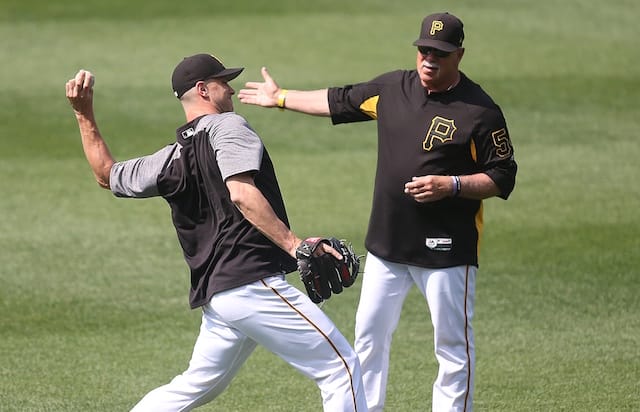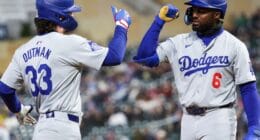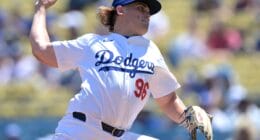The Los Angeles Dodgers shocked the baseball world on Monday with the acquisition of Texas Rangers ace Yu Darvish in exchange for Willie Calhoun, A.J. Alexy and Brendon Davis during the closing minutes of the July 31 non-waiver trade deadline.
With the Dodgers all but assured a fifth-consecutive National League West division title, trading for a rental of Darvish’s caliber is a move to further enhance the team’s World Series chances, and not just tacking on extra wins during the regular season.
Darvish’s presence gives the Dodgers a second ace for October, slotting in behind Clayton Kershaw, and with 2017 All-Star Alex Wood and Rich Hill presumably rounding out the backend of a postseason rotation.
The fact that Darvish has averaged over six innings per start in his career enables the team to put less pressure on the bullpen. Particularly Kenley Jansen, who pitched more than one inning on several occasions during the 2016 playoffs.
For now, Darvish gives the Dodgers rotation depth as Kershaw and Brandon McCarthy recover from their respective back and blister issues.
In 137 innings this season, Darvish has posted a career-high 4.01 ERA and 3.98 FIP with a career-worst 9.7 strikeouts and 1.3 home runs per nine inning. Despite the uncharacteristic results, there’s room for improvement.
For one, Darvish will now get to throw to Yasmani Grandal and Austin Barnes, ranked second and ninth, respectively, in runs above average. That’s compared to Jonathan Lucroy, who statistically is the worst pitch-framer in the Majors this season.
With Grandal and Barnes behind the plate, their ability to steal strikes from opposing hitters should allow Darvish to get ahead of the count more often, and thus, increase his strikeout total while limiting his walks.
Furthermore, a move from Globe Life Park, a hitters haven, to Dodger Stadium, should aid Darvish’s home run struggles this year. Not to mention he now gets to consistently face NL lineups with pitchers rather than designated hitters.
In fact, Darvish’s road splits already indicate that pitching away from Arlington, Texas, has proven beneficial. In 65 innings, Darvish owns a 2.49 ERA and 1.05 WHIP with an opponents’ slash line of .200/.271/.323.
For comparison, Darvish has pitched to a 5.38 ERA and 1.28 WHIP in 72 innings with batters hitting .247/.311/.458 against him at home.
Despite the Baltimore Orioles not trading Zach Britton, nor the San Diego Padres moving Brad Hand, the Dodgers still swung deals for a pair of intriguing southpaws from the NL Central in Pittsburgh Pirates setup man Tony Watson and the Cincinnati Reds’ Tony Cingrani.
Watson, eligible to become a free agent this winter, is the more notable of the relievers to join Los Angeles. An All-Star in 2014, Watson had spent his entire six-year career with the Pirates.
In 46.2 innings this season, the 32-year-old owns a 3.66 ERA, 4.69 FIP and 1.52 WHIP with 10 saves and a career-low 6.8 strikeouts per nine. Watson has allowed a career-high 11 hits per nine as well, though his .333 BABIP reveals he’s endured some tough luck along the way.
Left-handed batters are hitting .308/.357/.354 against Watson this year — a far cry from his career slash line of .217/.277/.293 with the platoon advantage. What’s interesting about Watson is that he ranks near the top in softest contact allowed.
Among pitchers with a minimum of 150 batted ball events, Watson checks in at second with an average exit velocity of 83.2 mph; right behind none other than Hill (83.0). Four other Dodgers pitchers round out the top-11: McCarthy (84.0, seventh), Maeda (84.1, eighth), Wood (84.2, ninth) and Kershaw (84.4, 11th).
The Dodgers are banking on Watson’s numbers skewing back to normal with a better defense behind him, among other factors. It doesn’t hurt that the left-hander will also be transitioning to a more pitcher-friendly ballpark as well.
From 2013-15, Watson pitched to a 1.97 ERA and 2.91 FIP in 224.1 innings while accumulating 3.5 WAR (FanGraphs) — the fifth-best mark among qualified left-handed relievers.
Should Watson’s production return even remotely close to that level, the Dodgers found a clear upgrade for their bullpen at a marginal cost.
Cingrani is a southpaw with experience as a starting pitcher and reliever in high-leverage situations. He’s not eligible for free agency until the 2020 season.
Cingrani began his career as a starter but has exclusively pitched out of the bullpen since 2015 — including a stop as Cincinnati’s closer just a year ago.
In 23.1 innings pitched this season, Cingrani has posted an unsettling 5.40 ERA and 7.01 FIP despite a solid 24.2 strikeout percentage and career-best 6.1 walk rate. The majority of his struggles have stemmed from the home run ball.
Cingrani is allowing a league-high 3.5 home runs per nine among pitchers with a minimum of 20 innings. Left-handed hitters have crushed Cingrani this season to the tune of a .293/.326/.829 slash line, as opposed to right-handed batters with a more modest .255/.321/.490 showing.
As is the case with Watson, the Dodgers took a flier on Cingrani and hope a change of scenery suits him well.
Given the circumstances, it’s impressive that the Dodgers were able to add another ace to its staff, along with potential bullpen reinforcements without dealing top prospects Walker Buehler, Alex Verdugo and Yadier Alvarez.
The front office did an outstanding job in putting the finishing touch on what was already baseball’s best roster, and now it’s up to the players to continue their winning ways from now through the end of October.





